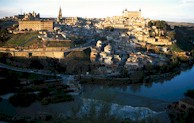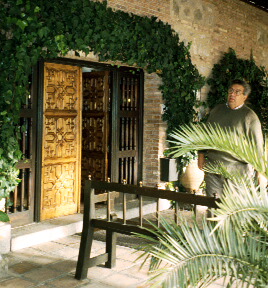TOLEDO SANS TOURIST
by Annette Lucido
Toledo’s infested with tourists who keep bankers
hours. Buses flood in around nine to
compound the crowds smart enough to take the train out from Madrid. Sometime between four and five the tide
recedes, the locals come out, and the shopkeepers relax and discuss their day. It’s the best of times.
The breeze from the river cools things down. It’s time for afternoon tapas, the now
ubiquitous Spanish snack food that started as a bit of this and that on a piece of
bread served atop a sherry. Best
of all, one of Spain’s best paradores, classic country inns the government runs
to improve job opportunities, is about a $5 taxi ride across the river and up the
hill on almost the exact spot where El Greco painted this most scenic town.

Toledo
photo credit: Annette Lucido
We’ve “done Toledo” both ways. The first trip, with a group of travel
writers bused us out from town to a non-stop narration of local history followed by a
quick walk through the highlights before a quite nice lunch at the Parador de
Toledo. These it might add run to
wonderful country dishes like baked onions stuffed with local sausages or
Spain’s contribution to breakfast – toast with a bit of olive oil, a
squeeze of lemon and a sprinkle of sugar. We whizzed through the cathedral, heard the
story about El Greco’s image in the church hit the big Santa Maria synagogue
and hit the road. At dinner that night I
noted all we’d missed and the amiable gentleman next to me, who turned out to
run Spain’s paradores, made arrangements for us to return. Reruns were better! 
The Parador Hotel
photo credit: Annette Bignami
We left the interesting Madrid rail station with odd bronzes and enjoyed a lovely, relaxing
ride through the country as we watched the scenery and checked up on guide
books. This time we reached the
wonderful cathedral with lots of time to enjoy the wildly decorated Gothic altar
reredos, or carvings, and the carved choir stalls. The monster painting of Hercules on one wall
vied with the El Greco in the Sacristy, the “three high” art in the small
gallery held us for nearly an hour.
There’s a great van Dyke way up in the corner that must have a story to
tell. There’s also a
cardinal’s hat hanging from the ceiling. Ask and they’ll tell you the story. Other Cathedral treats like the Tome’
altar can eat up most of the morning.
Not to worry, there’s at least another day here.
With so many images, a stroll down to the Plaza de Zocodover for some sherry and the odd tapas makes sense, and if the weather’s fine there’s a chance of an al fresco picnic here too. Then it’s time to stroll along streets one English urchin called “bloody humpy and lumpy” so make sure to bring your walking shoes. Every street has it’s own treasures. Sissies can hit the Tourist Information Center just off the plaza, otherwise just stroll and enjoy the shops. “Toledo Steel” goes back to dueling swords and shops are filled with wonderful Damascene blades and handicrafts the inlay precious metal onto sharp steel. Good spots to start to learn local history are the 1000 A.D. mosque now called the Ermita del Cristo de la Luz and the Taller del Moro that displays more Moorish handicrafts. The Moors, oddly enough were expelled from Spain the same year Columbus discovered America. For the earlier Visgoth period when Toledo was their capital in the 6th Century this was a most multicultural city indeed, and the San Raman church covers this period nicely. The Museo de Santa Cruz handles the rest of the local history with the help. Then there’s the old hospital now a museum with some dandy El Grecos.
El Greco is, of course, the most famous resident artist who died here in 1614, and, aside from the Cathedral there are a scatter of his masterpieces here. Some are in the Casa-Museo de El Greco – don’t miss the chapel underneath the museum and if you stay at the Parador de Toledo make sure to check the View of Toledo that you can compare later in mind’s eye as you check out today’s city from the Parador terrace.
But however artful, Toledo is a real town when the tourists leave. Take time to feast your eyes on the shops, the architecture and don’t forget to treat your tummy with some of the famous Toledo marzipan that comes in more shapes than tourists. Meals need not be fancy. The local bread is wonderful and a big bowl of garlic soup works nicely for dinner that may be served as late as 10 o’clock. We favor a big lunch instead. Local dishes like the suckling pig or roast lamb from La Lumbre or Hostal del Cardenal, a nice hotel that’s in the Cardinal’s old home, are top line. Local trout from the river and, in winter, the best time to visit if you don’t mind cold weather and a stark, sere landscape, there’s prediz and other game birds and game.
Most of all, if you allow two or even three days, you become part of the town. Stop at the same café twice and you’ll be a demi-regular. Ask, in Spanish if you can, about special local meals, or stop in a cheese or sausage shop or bakery for the makings of a picnic down by the river. Ask the fishermen about their luck, the locals about the weather and wind down from hectic tourist mode. Toledo’s the spot, and off season’s the time to capture some of the feel of Spain in it’s glory days when the treasure galleons braved the British gauntlet to bring home the treasures of the new world.
